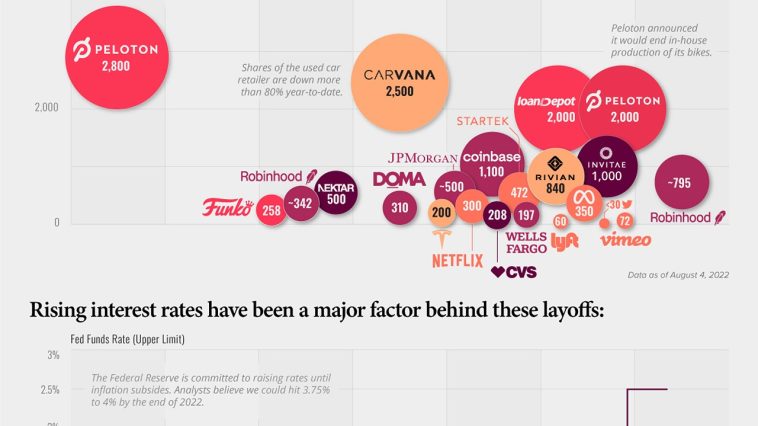LISTEN HERE:
This week, a wave of organizations unveiled plans to cut their workforces. These job reductions follow the layoffs announced by both The Walt Disney Co. and Amazon. Disney initiated their second round of dismissals on Monday, with approximately 4,000 people affected according to Reuters, adding to those from the first round in late March. A third round of cuts will occur “before the beginning of summer” to accomplish the 7,000 total layoffs announced by Disney CEO Bob Iger in February.
In the meantime, Amazon’s cloud computing and human resource departments experienced layoffs on Wednesday, following the company’s announcement in March of plans to cut 9,000 more positions. The retail titan aims to reduce its total workforce by 27,000 this year. Several other companies have also revealed layoff plans this week.
Lyft, the ride-sharing platform, announced on Thursday that around a quarter of its total workforce will be affected by the most recent job cuts. According to a filing with the Securities and Exchange Commission, the operating cost savings Lyft anticipates from the 1,072 dismissed employees and restructuring efforts will be utilized to enhance service for both riders and drivers.
Last week, new Lyft CEO David Risher foreshadowed these cuts in a company-wide email, stating that the company must become a “faster, flatter” organization where “everyone is closer to our riders and drivers.” As an additional cost-saving measure, Lyft also eliminated over 250 job openings.
On Thursday, Dropbox CEO Drew Houston announced in a blog post that their global workforce will be trimmed by 500 employees, approximately 16% of the total staff. The affected individuals were notified on the same day. Houston cited the “natural maturation” of Dropbox’s existing enterprises and the influence of the economic downturn on the company’s growth as reasons for the layoffs.
The CEO also mentioned that Dropbox’s “next stage of growth” requires a diverse range of skills, particularly in artificial intelligence (AI) and early-stage product development. As part of their focus on AI efforts, Dropbox reassigned employees to different teams “wherever possible,” according to Houston’s blog post.
First Republic, a bank affected by the recent financial crisis, indicated on Monday that it will implement layoffs, reducing its workforce by 20-25%. At the end of last year, the regional lender had over 7,200 full-time equivalent employees, including temporary workers and contractors. Alongside the layoffs and other cost-cutting initiatives, First Republic aims to “increase insured deposits, reduce borrowings from the Federal Reserve Bank, and decrease loan balances to correspond with reduced reliance on uninsured deposits.”
Gap Inc. announced on Thursday that approximately 1,800 workers within its corporate and upper field workforce will lose their positions. The majority of these layoffs and related actions are anticipated to take place within the first half of fiscal 2023. Interim CEO Bob Martin stated, “We are taking the necessary actions to reshape Gap Inc. for the future – simplifying and optimizing our operating model, elevating creativity, and driving better delivery in every dimension of the customer experience.”
Martin also mentioned the previous announcement of standardized brand leadership structures intended to flatten the organization, ultimately improving decision-making and reducing overhead expenses. Gap’s restructuring efforts aim to save the company around $300 million.
Deutsche Bank’s CEO Christina Sewing informed analysts and investors on Thursday that the bank will start to “reduce senior non-client-facing workforce by 5%” and “limit new hiring” for these positions. Both “right-sizing” moves will begin in the second quarter. The bank’s other “efficiency measures” include streamlining the mortgage platform and further downsizing its technology center in Russia.
3M announced its plan to make the company “stronger, leaner, and more focused” by reducing the total number of employees by 6,000. The multinational conglomerate disclosed this decision during the reporting of its first-quarter earnings on Tuesday. Earlier in January, 2,500 manufacturing employees had already experienced layoffs.
Tyson Foods joined the lineup of companies announcing job cuts this week on Wednesday. According to Reuters, the Arkansas-based company intends to reduce some senior leadership and corporate positions. In March, Tyson Foods announced the elimination of 1,700 jobs in connection with the closure of two chicken plants.
For senior leadership positions, the newly-announced reductions will affect 15% of the workforce, while 10% of corporate staff will feel the impact. As multiple companies take drastic measures to adjust their workforces amidst economic challenges, it becomes increasingly vital for employees to adapt and respond resiliently.
While these companies confront change, it highlights the challenges that businesses face and the need for flexibility and innovation during tumultuous times such as these. As organizations wrestle with tough decisions, it is the resiliency and resourcefulness of those who persevere that will shape the landscape of the entire industry and economy.
As each company maneuvers through these workforce adjustments, it underscores the importance of continuously striving for growth and stability in response to shifting economic conditions. Adapting to the ever-evolving landscape is key to overcoming challenges and securing a thriving future for both businesses and their employees.


